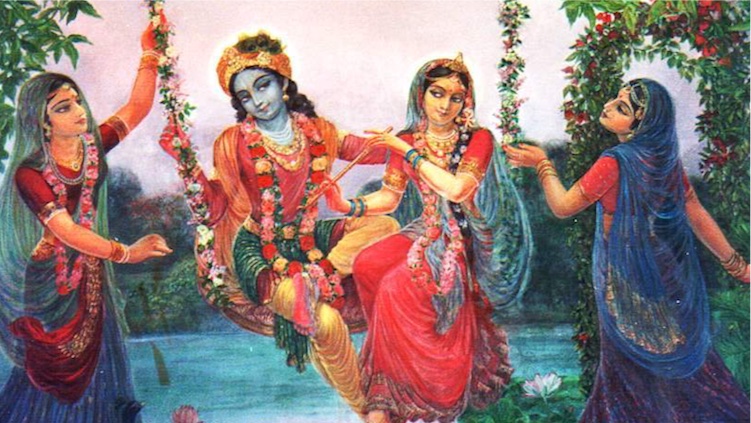The Party That Never Ends
By Dr. Sahadeva Dasa | Сен 04, 2015

Dream fade, bubbles pop, dew evaporates and lightning ceases [1]. Nothing is permanent here.
All things change. Time is cruel. It shows no mercy. Wheel of time crushes everything in its way. When time is up, it’s up. Respect the sheer power of time.
A poet says,
“This thing all things devours / Birds, beasts, trees, flowers
Gnaws iron, bites steel, / Grinds hard stones to meal,
Slays king, ruins town, / And beats high mountain down!”
Time is a universal ingredient here. Everything is produced in time, stays in time and perishes in time.
But there is a place and there are beings, completely beyond the influence of time. Everything is eternal there. No one ever dies or grows old. Time is not divided into past, present or future. That realm, characterized by complete happiness, full consciousness and permanence, is known as Vaikuntha, the spiritual world. This place is free from all anxiety. Here every word is a song and every step is a dance.
God, the Absolute Truth and the Supreme Being, resides there along with His energies and expansions. His pleasure potency expands as His eternal consorts. Chief of such eternal consorts is Radharani, and He is known as Krishna.
Srila Prabhupada, the founder of the Hare Krishna movement, explains the difference between these two worlds: “Here, in this material world, we have to work. Without work, you cannot maintain even your family, your body. That is not possible. Sarira-yatrapi te na prasiddhyed akarmana – Krsna says to Arjuna that without karma you cannot maintain even your body. So you have to work. Sarira-yatrapi te na prasiddhyed akarmana-. And this material world means you have to maintain by working. And spiritual world means na tasya karyam karanam ca vidyate. There is nothing to work, as Krishna has nothing to work. He is simply enjoying What is called? Swing. So Krishna is enjoying, and Krishna’s associates are enjoying. They have nothing to work. That is spiritual world. Cintamani prakara sadmasu kalpa vrksa: that is a different world. There is no material body. Therefore there is no need of the material body. That is a different world. But in this material world we have to work.”
This Divine Couple, Radha and Krishna, eternally engage in loving pastimes. These loving pastimes are enacted on the spiritual platform, which is free from the contamination of material inebrieties. The ocean of bliss, emanating from these loving pastimes, expands continuously. Every moment is a festival or a party that never ends.
One of such divine parties is the monsoon swing festival. Srila Kavi-karnapura, a prominent Sanskrit scholar, explains this in his book, Ananda Vrindvana Champu [2] :
“The swing festival was held in a special place in Vrndavana, which was bordered by a line of desire trees of equal height, with round trunks and branches whose ends intertwined, leaving barely any space in the middle. The line of trees appeared like a wall of sapphire jewels. Besides the birds inhabiting those trees, the presiding deities of the forest had placed various items in the trees including chamaras, silk cloth, long strands of pearls, jewels, fruits and flowers. A square shaped golden stage stood in the center of the decorated trees. In the middle of the stage was a jeweled kunja with four doors. Four harichandana trees stood as pillars in the corners of the kunja. The intertwining of the tree’s upper branches formed an overhead canopy. The swing hung on thin golden ropes tied to the branches of the haricandana trees. This arena appeared in the center. Each gopi group leader had a personal kunja with a swing in the four directions radiating from this central arena.”
“The other arenas, lined with pleasant devataru trees, radiated green all around and resonated with the singing of young cooing birds. They served as embodiments of festivity for the entire earth. One swing hung from each pair of trees, and sitting platforms for the gopis encircled the bases of these trees. Golden chains tied securely to the branches of the trees hung down in straight lines. In the center arena four lines of swings belonging to different group leaders faced the four doors of the main kunja. Herds of deer frolicked about joyfully in the flat, open land surrounding the kunjas. The hearts of everyone immediately flooded with joy just by seeing these areas, which were illuminated by cintamani gems and by trees as brilliant as coral. The top branches of the trees joined to form natural, pleasing green canopies. Gazing upward forever one could not find the tops of those tall trees.”
“The moonlight filtering though the canopies of the trees made small filaments of light on the forest floor that looked like piles of sesame and rice. Thinking it food, the female deer tried to lick it. The four kunja mandapas (raised platforms) were so similar that even the devatas could distinguish them only by their placement in different directions. In those areas, the vanadevis had stretched a canopy in preparation for the swing festival.”
“The scattered moonlight appeared like pearl belts taken from the deities of the directions, broken by the steady wind, and broadcast on the earth out of respect for the land of Vrndavana. It appeared as if all the stars in the sky, in great bliss, left their positions to come and offer respects to the land of Vrndavana. Pieces of rustling silk cloth from the goddess of the sky formed the rooftops of the kunjas and hung down quivering like tongues trying to lick the dust of Vrndavana. The nets of pearls hanging from that cloth were swinging gently in the soft breeze and pleasantly resounding like tinkling ankle-bells (Excerpts).”
* * *
Reference
1.Ven. Wuling, Path To Peace, 1998.
2. Ananda Vrindavan Champu by Srila Kavi Karnapura, Translation by Bhanu Swami & Subhaga Swami, Published by Mahanidhi Swami, 2003.















